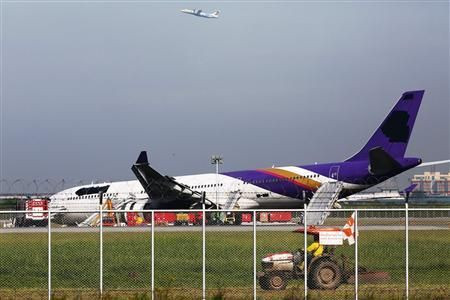Struggling Thai Airways Gets $1.8 Billion Government Bailout With Strings Attached

KEY POINTS
- Thai Airways is 51% owned by the Thai government
- The bailout is conditional upon the airline rehabilitating itself
- Thai Airways has incurred losses over the past three years
Thailand’s beleaguered state-controlled airline, Thai Airways, has received an $1.8 billion bailout until the end of the year to keep it afloat.
The Thai government, which owns 51% of the flag carrier through the Ministry Of Finance, will form a committee of aviation and business professionals to oversee the airline while it undergoes debt restructuring.
Thai Airways’ troubles emerged long before the coronavirus pandemic shut down global air travel. Since 2017, when the carrier posted a net loss of $65 million it has been accumulating unsustainable amounts of debt – while incurring widening annual losses.
The airline's debt-to-equity ratio climbed to 21 in 2019 from 12 in 2018 and 7.8 in the prior year.
Consequently, the bailout loan – approved by the State Enterprise Policy Committee, which is chaired by Prime Minister Prayut Chan-o-cha – is dependent upon the airline presenting a viable plan to rehabilitate itself by cutting expenses, renegotiating debts, etc.
As such the loan will be paid out in tranches to make sure the airline sticks to a strict rehabilitation program.
Thai Airways will likely have to streamline its operations, lay off workers, alter its route network and reduce the size of its 103-aircraft fleet.
If the airline’s plan is approved by the government next week, Thai Airways will probably issue new shares in November to raise funding.
“Thai Airways is so ingrained in the country’s identity and tourism industry that it’s not a surprise the government is willing to rescue it,” wrote Emily Derrick in Simple Flying. “The government seems to be taking a sensible approach in overseeing how the money is spent, not just providing the money. The question is, if this bailout package is not successful, how far will the government go to keep its national carrier?”
The carrier has long caused stakeholders headaches.
In 2019 Thai Airways posted a loss of about $105 million, despite the fact that its passenger traffic increased. At the time the carrier blamed, among other factors, the civil unrest in Hong Kong, strong competition from low-cost carriers and Middle Eastern operators, as well as the U.S.-China trade war.
Last November, Thai Airways' chairman Ekniti Nitithanprapas resigned from his position, most likely under pressure.
At that time, serious questions were already being raised about the airlines’ viability and survival.
The government had already pressured the airline to scrap a $5 billion project to modernize its aging fleet. Thai Airways also had the reputation of having an overpaid management, while serving as a kind of private air shuttle for the country’s elite.
Thai Airways president back then Sumeth Damrongchaitham (who has since resigned) said the airline was in a “crisis” mode and faced “possible closure.”
“The competition is very fierce this year,” Sumeth said. “[Thai Airways] is really in a crisis. Next year it must do its best… Today very little time remains. Today there is no comfort zone. Everyone will die if the vessel sinks.”
Deputy Transport Minister Thaworn Senneam said in October the airline “is now in crisis. Its financial status is in a critical condition.”
But Sumeth was unwilling to cut staff,
“We are not considering layoffs or lowering wages,” he said. “We saw a temporary recovery in earnings after a previous layoff, but we returned to the red the following year.”
© Copyright IBTimes 2025. All rights reserved.





















